Features
EBS 35 Years: Interview with the founders of EBS, CEO Bo Engberg and Tech Director Mats Kristoffersson
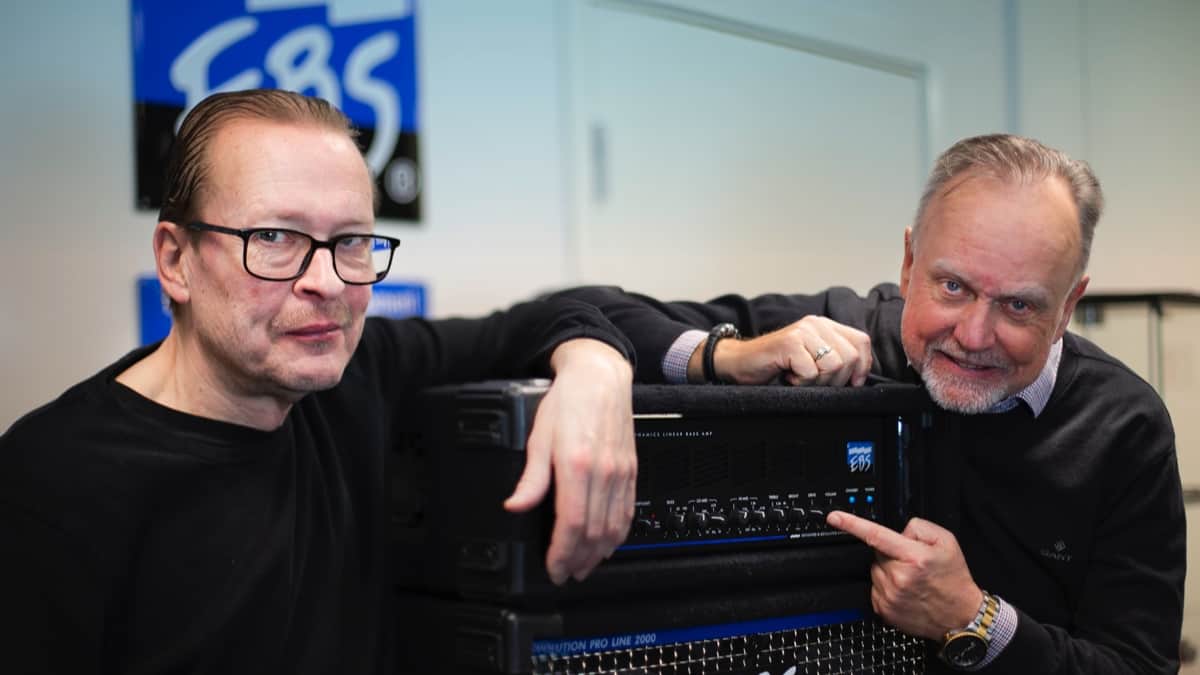
EBS 35 Years: Interview with the founders of EBS, CEO Bo Engberg and Tech Director Mats Kristoffersson Written by Joel McIver
Thirty-five years is a long time to be in business.
The Beatles only managed eight years. ABBA just about made it to ten. Even Led Zeppelin split after only twelve—and yet the unique creative partnership of Bo L. Engberg and Mats Kristoffersson, the CEO and Technical Director respectively of the pioneering amp and effects company EBS, is as strong as ever after a third of a century and counting.
“Thirty-five years? I can hardly believe it!” chuckles Bo when we ask him how he and Mats have managed to stay the course for so long. “You know, I’ve always had a voice in my head that said ‘Never give up—keep going!’”
Sound business sense and determination aren’t the only factors behind the company’s success, though. The fact that Bo and Mats complement each other so well, not just in business and product design but also in personality, has played a huge part.
“He and I are very different in every way,” chuckles Bo, “but we’re a very good team. I’m an extrovert, so I have no problem with meeting people, anywhere and everywhere. My other strength is that I can run the business efficiently. Mats is an incredible designer and builder. I’ve never seen anyone else like him. He can handle tubes, transistors, and digital technology—he has no limits.”
From this description by his effervescent business partner, you’d expect Mats to be a quiet fellow who keeps his own counsel, and indeed EBS’s design supremo is more reflective than outspoken. Dig deeper, though, and he admits that as a teenage electronics whiz, he once boasted: “I’m going to build the best bass amp in the world one day!”
Asked if he’s achieved this goal yet, Mats laughs and says: “I know we’ve made some incredible amps here, because some of the world’s greatest bassists tell us that themselves. Are they the best in the world? I’ll let those players decide—and you know what? There are still bass amps to come.”

EBS founders, Mats Kristoffersson and Bo Engberg at the EBS Headquarters in Stockholm, 2023.

The first ever EBS product, the famous EBS-1 preamp from 1988.

Billy Sheehan, Mats and Bo at the startup meeting for the Billy Sheehan Signature Drive in Billy’s studio in Sherman Oaks, California, January 2011.
04 The EBS Magni 502 combo. One of the most recent creations from EBS, released in 2022.
All images courtesy of EBS
The Early Days
“When I was a small boy, even before I started school,” begins Bo, “I had three big interests—music, electronics and business. I had no problem with the first one, but I knew nothing about the other two: I just knew I liked them. When I was a kid, music was the most important of the three. One of my friends at school made a bass guitar—a very bad one!—but I played it and I loved it.”
Like Bo, Mats was an early starter when it came to playing music. “I started playing drums when I was nine, and moved to bass a year later,” he remembers. “I went to a very good music school, and I moved pretty fast: I was playing jazz-rock and Santana covers by the late Seventies. I was pretty dedicated—sometimes I’d rehearse or play shows six days a week. It was tough, with 15 guys on stage and not much money between us all, but we had a great time.”
Rocking out was fun for Bo too, but he already knew he wanted to go into a music-related business rather than pay his bills as a musician. “I played in a weekend band, but it was just a hobby,” he says. “My first amp was a 30-watt Hagstrom with two 15-inch speakers. It wasn’t very loud, but it was fun. My bass was an Epiphone. I didn’t have any money, so that was all I could afford.”
And the name of his band? “We called ourselves Järngänget, which means Iron Gang, ha ha! Later I joined Stämmbandet, playing Chicago covers, and finally I ended up in a band called Moby Dick. After that I worked as a studio and production technician for a long time, around 15 years, but I was always planning to set up an electronics and audio company. One of my early ventures into gear design had already taken place in 1979, when I started my first company and developed a guitar amp for a Swedish guitar dealer, Jan Hallquisth. Jan’s nickname was ‘Halkan’, so that’s what I called his amp.”
The decision to enter electronics was equally easy for Mats, who remembers: “The moment came when I had to choose whether to enter a technical career or become a professional musician, but I always knew which way to go.”
Taking Effect
By 1985 Bo had plunged his savings into his company, Efekt Elektronik—misspelled with a single F because another company existed called Effekt Elektronik when he tried to register the name. He didn’t bother seeking out venture capital or private equity, preferring to finance everything himself and maintain complete control.
Meanwhile, Mats was hard at work studying electronics, and this was where the two men first crossed paths. “I had a dream in 1985,” explains Bo. “I wanted to create a kind of Kalman filter that reduces feedback from acoustic instruments and automatically tunes them by reducing their resonant frequencies. I asked two guys who knew electronics to come in and try to solve this problem, but it was too advanced for them.”
Fortunately for Bo and the future of the bass gear industry, the young electronics enthusiasts knew where to go for help. “They said to me, ‘We have a guy in our class called Mats Kristoffersson who helps companies out with this kind of thing’,” adds Bo. “They talked to him and he came by. I presented my idea to Mats, and he solved the problem—and then he said, ‘Okay, what’s our next project?’ That’s how we started working together.”
The turning-point came in 1988, when Bo told Mats about an concept he had for a bass guitar preamplifier. The idea behind the unit was to make a simple but incredible-sounding preamp based on the the highest-quality components available.
The initials of the new Efekt Bass System were soon adopted by users as the name of the company that made it, and so EBS was born, with the EBS-1 preamp its launch product. “After that, we changed our focus, because we now knew what we wanted to do,” nods Mats, pointing to a whole list of new innovations that followed shortly afterwards. “We were the first company to put a treble horn in a 4×10” cab, and among the first to put a compressor in an amplifier,” he explains, noting in passing that these features are now commonplace worldwide.
Milestones
By 1992 EBS had developed and launched several new power amps, including the EPS-600, EP-200 and EB-800, as well as several cabinet models and the 240-watt Taurus combo. The last of these was a dream come true for bassists looking for the perfect balance of portability and tone modulation.
“It was our first combo,” says Bo, “so we wanted to do something very special with it. We came up with the idea of filling it with effects—a compressor, octaver, and chorus. This was really new for bass players: they hadn’t seen this before.”
The Taurus effects were so popular that a whole new product line was born for EBS when Bo and Mats split the effects away from the amp and sold them as individual pedals. “People loved the effects that were in the amps,” explains Bo, “so I told Mats, ‘Why don’t we take them out and make separate pedals instead of having them built into the amplifier?’”
In 1995, the Fafner hybrid bass amp—a preamp and power amp occupying the same unit—was launched. Named after a fearsome dragon from Norse mythology, the Fafner quickly stamped the EBS name across this market sector, and returned in 2011 as the Fafner II Extreme Edition. A dual-channel beast, the Fafner II became widely used by bands across the genre spectrum: at one point, three out of the five nominees in the American Grammy Awards’ Metal Album Of The Year category were recorded with an EBS Fafner II, including the winning album—even though none of the bassists concerned were official EBS endorsers.
By the late Nineties, EBS equipment had spread across the globe and was available in Japan, the USA and most of Europe. When the company’s tenth anniversary came around, its catalogue included the Fafner amp, combos, cabinets and pedals—including the famous UniChorus, MultiComp and OctaBass—as well as all manner of accessories. An Anniversary edition of the EBS-1 appeared in 1998, the Classic-1, reminding us which preamp started it all.
In more recent years, EBS has developed the two popular HD360 and TD660 solid-state amplifiers. The HD has become a favourite with artists such as Tal Wilkenfeld, while the TD is often seen among backline rentals as well as on tour.
As the years have passed, EBS has continued to respond to the changing demands of the marketplace. The NeoLine cab series found a ready home among metal bands from Sweden and abroad thanks to their punchy response, while the EBS Classic line of cabinets and amps was immediately embraced by a new wave of classic rock bands who needed warmth, power and reliability from their bass gear.
Take note, too, of the remarkable technology behind the lightweight Class-D Reidmar range of amps, launched in 2011. In ancient Norse literature, Reidmar was the dwarf who slew Fafner, although in EBS’s case the two products coexist peacefully. Mats’s Soft Clip solution ensures that sound quality is maintained even when the automatic limiter that controls clipping is pushed to its limits, a formerly insoluble issue for Class-D amps.
These days, you’ll find dozens of EBS products ready for the world’s bassists. There’s no stopping EBS now.
The People—And The Future
EBS has an enviable range of high-profile bass players on its roster. Back in the early days, renowned bassists such as Stefan Brolund and the late Kofi-Bentsi Enchill were invaluable partners for EBS, for their feedback during the product development process as well as their roadshow appearances.
Two world-renowned bass players that you’ll see proudly using EBS pedals are Billy Sheehan and Stanley Clarke. Billy’s acclaimed Drive pedal is the result of painstaking research, with the great bassist and the company designers working together to build the ultimate overdrive. The original version of the Drive was introduced at Winter NAMM 2013, while the later Deluxe model added even more essential functionality.
As for the Stanley Clarke Signature Wah-Wah/Tone Filter pedal, which offers the player wah and tone filter options as well as the ability to approach the Clarke active tone with a passive bass, it’s the perfect synthesis of bass innovation and manufacturing know-how. EBS also released Stanley’s signature Acoustic Preamp in 2021, an essential unit for any upright bass player.
Other artists whose collaborations with EBS have been long and productive include the session great Tal Wilkenfeld; Henrik Linder of the unique Dirty Loops; and Prince’s former bassist Dywane Thomas Jr., better known as MonoNeon. The music of the pop star Harry Styles, who won a Grammy for Album of the Year in early 2023, also rests on EBS thanks to Elin Sandberg, a Swede who the company has supported since she was 17, just before she moved to the USA to study at Berklee.
If you’re an American football fan, you may have heard the EBS bass tone underpinning recent half-time shows led by musical director and bassist Adam Blackstone. Meanwhile, another high-profile EBS user is Alex Al, the bass player on the Arsenio Hall and George Lopez shows, who has played with a list of world-class artists such as Michael Jackson, Stevie Wonder, George Benson, Herbie Hancock, and Lionel Richie.
Sweden is known internationally for its heavy metal bands, and many heavyweight bassists from that movement, particularly its Gothenburg branch, trust EBS to deliver the low end. These include the former In Flames bass player Peter Iwers and At The Gates founder Jonas Björler. American metal titans Steve Di Giorgio of Testament and John Campbell of Lamb Of God also place their faith in EBS: it’s little surprise that the company is the main bass backline provider at the annual Sweden Rock Festival, the country’s biggest event for lovers of loud music.
Ask Bo to name a memorable EBS moment from the last 35 years and he’ll tell you about the night that the old millennium became the new one. “I’ll always remember December 31, 1999!” he tells us. “We were watching the Swedish rock group Europe, who were playing their huge hit ‘The Final Countdown’ on a boat in the middle of Stockholm. It was minus 15 degrees—really, really cold—and they were using the biggest amp rig that EBS has ever built. The sound was incredible, and it was a total validation for us of all the hard work we’d done to get to that point.”
It’s 24 years since that memorable night, but the mission to serve bassists’ needs continues as strongly as ever with the launch of the new EBS Magni combo, an amp for which your lower back will thank you forever. “The Magni is very loud, and very light,” confirms Mats. “It’s actually the lightest bass combo we’ve ever made, at around 15 kilos, or 33 pounds, and it has a double porting system so the sound will go everywhere. The drummer sitting next to you will say, ‘Hey, you sound great!’
Ultimately, EBS is able to meet the needs of a huge international community of bass players because Bo and Mats are the same people at heart that they used to be all those years ago—bassists who love music in all its forms.
“It’s simple,” says Bo. “EBS is staffed by dedicated musicians whose interest and focus is bass. Our company represents every imaginable style of music—rock, pop, blues, jazz, funk, Latin, traditional folk music and so on. For us, there are no boundaries. Music touches me, regardless of style, musician or lyrical message—everything from classical music to metal.”
Thirty-five years since Bo and Mats put their heads together and the EBS-1 was born, their mission is the same as it ever was. “As a bass player, you have a dream tone in mind,” says Bo. “That tone is what we’ll deliver to you. Just as we were in 1988, we’re at your service!”
Visit online at ebssweden.com
Features
Alberto Rigoni On Unexpected Lullabies
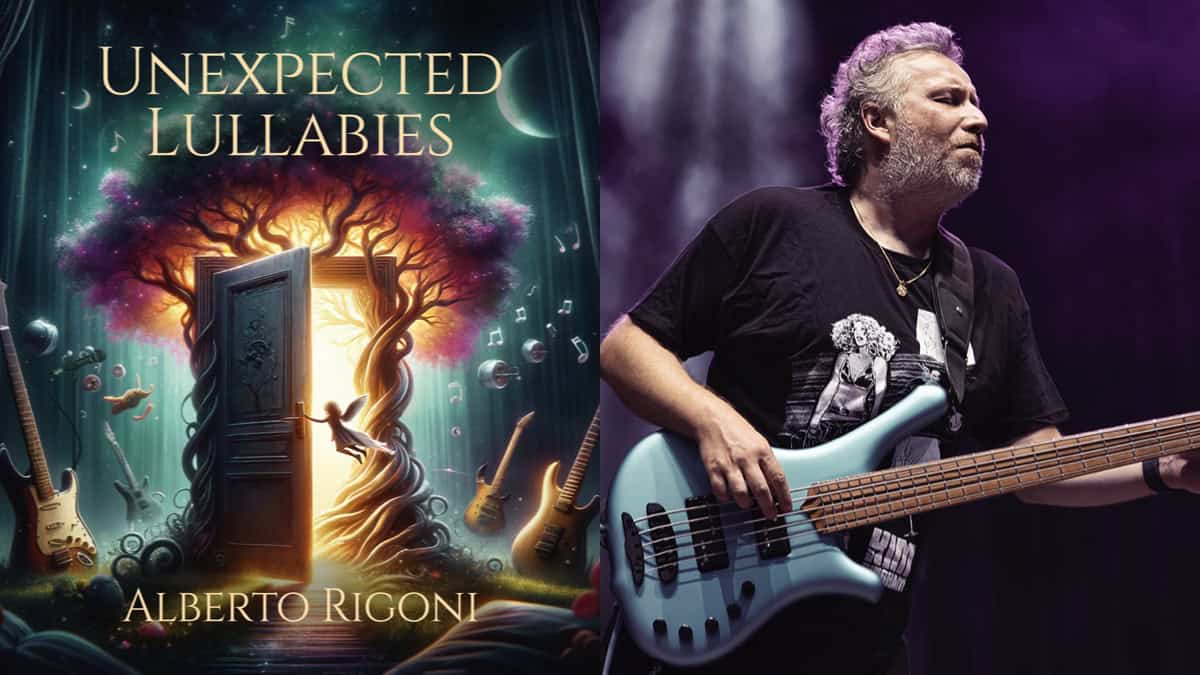
Readers have been fans of the composer, bass player, and Bass Musician contributor Alberto Rigoni for some time now.
In this interview, we had the opportunity to hear directly from Alberto about his love of music and a project near and dear to his heart, “Unexpected Lullabies”…
Could you tell our readers what makes your band different from other artists?
In 2005, I felt the urge to write original music. My first track was “Trying to Forget,” an instrumental piece with multiple bass layers (rhythm, solo, and arrangement), similar to the Twin Peaks soundtrack. When I played it for a few people, they really liked it, and I decided to continue composing based on my instinct and ear without adhering to any specific genre. In 2007, I released “Something Different” with Lion Music. The title says it all! Since then, I’ve released many solo albums, each different from the others, ranging from ambient to prog, fusion, jazz, and new age. I am very eclectic!
How did you get involved in this crazy world of music?
As a child, I listened to the music my parents enjoyed: my dad loved classical music, while my mom was into Pink Floyd, Genesis, Duran Duran, etc. These influences left a significant mark on my life. However, the turning point came at 15 when a drummer friend played me “A Change of Seasons” by Dream Theater, which was a shock! From that moment, I decided to play bass and cover Dream Theater songs, which I did for many years with my cover band, Ascra, until it disbanded in 2004. After that, I joined TwinSpirits (prog rock) led by multi-instrumentalist Daniele Liverani. Since then, I haven’t played any more covers!
Who are your musical inspirations, and what inspired the album and the songs?
My roots are in progressive rock metal, with influences from bands like Dream Theater, Symphony X, and many others. However, I listen to all genres and try to keep an open mind, which helps me compose original music. On bass, I was significantly inspired by Michael Manring and Randy Coven (bassist of Ark, Steve Vai, etc.). But I don’t have a real idol; I just follow my own path without compromise.
What are your interests outside of music?
Living in Italy, I love good food and wine! Beyond that, I have a deep interest in art in general and history, not just of my country. I enjoy spending time with friends, skiing, biking, and walking in nature. This is how I spend my free time. The rest of my time is devoted to music and my family!
Tell us about the new album.
It is definitely an out-of-the-box album. When I found out last year that I was going to have a baby girl, I decided to compose a sort of lullaby album, but I didn’t want to cover already famous lullabies. So, I started composing new tunes with the goal of creating an album that was half-sweet and half-hard rock. I did include some covers like “Strangers in the Night” by Frank Sinatra, sung by Goran Edman, former lead singer of Malmsteen. It’s not exactly a lullaby, but I felt the lyrics fit the album, as does the instrumental version of “Fly Me to The Moon.” There are also tracks with just bass and piano (Nenia) or two basses (Vicky). It was definitely an interesting creative process!
What is the difference between the new album and your previous releases, and will there be any new material from your other outfit called BAD AS?
BAD AS is essentially a metal band with several influences including prog. My solo genre is quite different, although there are some metal songs on a few albums. It’s always difficult for me to categorize my music… let’s say it’s a mix of prog, ambient, fusion, and new age.
Where was the album recorded, who produced it, and how long did the process take?
I produced my last album entirely by myself, including mixing and mastering. Unlike other albums I’ve produced within a few months, this one took much longer, perhaps because I was very busy or maybe because I wanted it to be perfect for my daughter, who is now three months old. In any case, I am satisfied. Once again, I did something different from my previous albums.
What is the highlight of the album for you and why?
My favorite song is the first track titled “Vittoria,” named after my daughter. It’s the intro to the record and isn’t very long, but the melody stuck in my head. Another standout track is the instrumental version of “Fly Me to The Moon” by Frank Sinatra, where I used fretless bass. The first part is sweet, the second part definitely rocks!
How are the live shows going, and what are you and the band hoping to achieve?
With BAD AS, this year we shared the stage with David Ellefson’s (former Megadeth bassist) band and talented young singer Dino Jelusik (White Snake). We plan to continue performing all over Europe!
What’s in store for the future?
I am working on an instrumental project called Nemesis Call, a progressive shred prog metal album with various influences. It will feature guest appearances from famous musicians like drummers Mike Terrana and Thomas Lang, as well as young talents like Japanese guitarist Keiji from Zero (19), 14-year-old Indian drummer Sajan Young, and guitarists Alexandra Zerner and Alexandra Lioness, Hellena Pandora. It’s scheduled for release at the end of the year or early 2025. As an independent artist, I have launched a fundraising campaign with exclusive pledges at www.albertorigoni.net/nemesiscall. And no, I am not begging; the album will be released anyway!
What formats is the release available in?
Unexpected Lullabies is available both as a Digipack CD and on streaming platforms.
What is the official album release date?
June 4th, 2024.
Thanks for this interview Bass Musician Magazine and for the continued support to my career!
Visit Online:
www.albertorigoni.net
www.youtube.com/albertorigoni
albertorigoni.bandcamp.com
www.instagram.com/albertorigonibassplayer
www.facebook.com/albertorigonimusic
www.tiktok.com/@albertorigonibassist
CD Track Listing:
1. Vittoria
2. Fly Me to the Moon
3. Azzurra
4. Dancing with Tears in My Eyes (feat. John Jeff Touch)
5. Out of Fear
6. Veni Laeatitia (feat. Alexandra Zerner)
7. Nenia
8. Slap Lullaby (feat. Karl Clews)
9. Saga
10. Vicky (feat. Michael Manring)
11. Ocean Travelers (feat. Vitalij Kuprij)
12. Strangers in the Night (feat. Göran Edman)
13. Peaceful
14. Un uomo che voga (feat. Eleonora Damiano)
Band Line-Up:
- Tommaso Ermolli arrangements on “Vittoria”
- Sefi Carmel on “Fly Me to the Moon” (Cover) (except for the keyboard solo by Alessandro Bertoni)
- Piano and keyboards by Alessandro Bertoni on “Azzurra”
- Leonardo Caverzan, guitars, and John Jeff Touch, vocals on “Dancing with Tears in my Eyes” (Cover)
- T. Ermolli keys on “Out of Fear”
- Alexandra Zerner everything on “Veni Laetitia”
- Daniele Bof piano on “Nenia”
- Karl Clews, piccolo bass on “Slap Lullaby”
- Jonas Erixon vocals and guitars on “Saga”
- Michael Manring bass on “Vicky”
- Vitalij Kuprij, keyboards and piano, and Josh Sapna, guitars, on “Ocean Traveler”
- Göran Edman, vocals, Emiliano Tessitore, guitars, Emiliano Bonini, drums, on “Strangers in the Night” (Cover) everything by Alberto Rigoni and vocals by Federica “Faith”
- Sciamanna on “Peaceful”
- T. Ermolli, guitars, and Eleonora Damiano, vocals, on “Un uomo che voga All drums programmed by Alberto Rigoni
Bass Books
Interview With Barker Bass’s Inventor and Writer Lee Barker
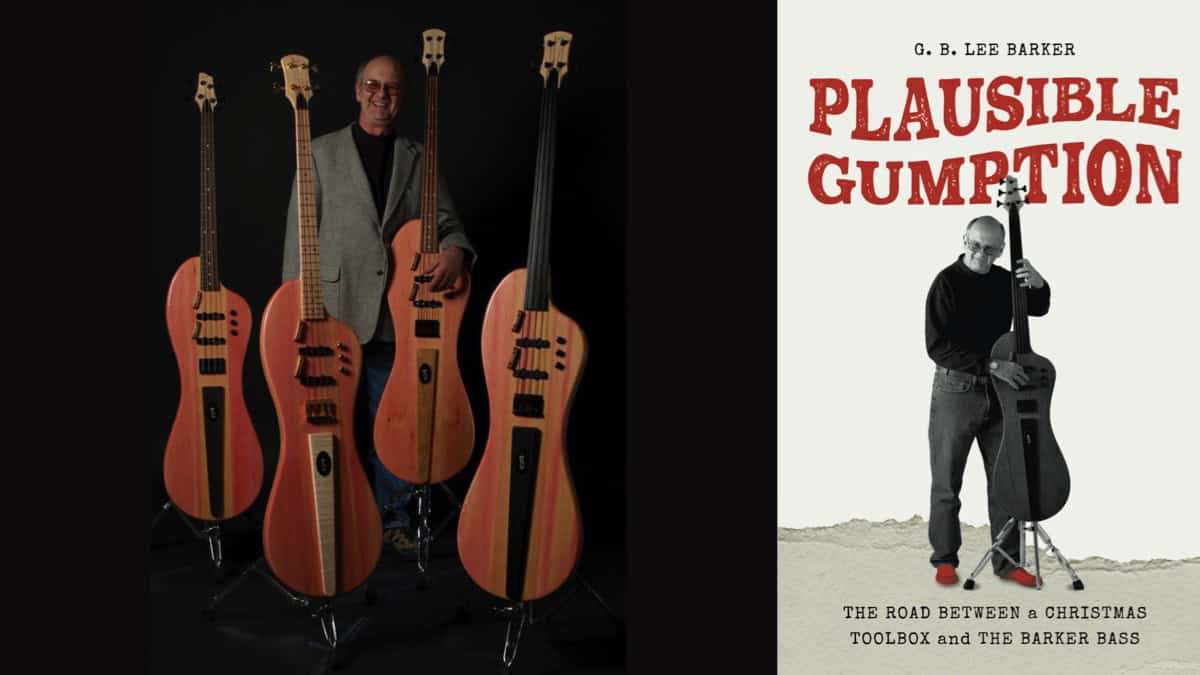
If you are an electric bass player, this is an exciting time to be alive as this relatively new instrument evolves around us. Some creative individuals have taken an active role in this evolution and made giant leaps in their own direction. Lee Barker is one of these inventive people having created the Barker Bass.
Fortunately, Lee is also an excellent writer (among so many talents) and has recently released his book “Plausible Gumption, The Road Between a Christmas Toolbox and The Barker Bass”. This book is a very fun read for everyone and shares a ton of details about Lee’s life in general, his experiences as a musician, a radio host, and a luthier. Now I am fortunate to have the great opportunity to gain even more insights into this renaissance man with this video interview.
Plausible Gumption, The Road Between a Christmas Toolbox and The Barker Bass is available online at Amazon.com
Features
Bergantino Welcomes Michael Byrnes to Their Family of Artists
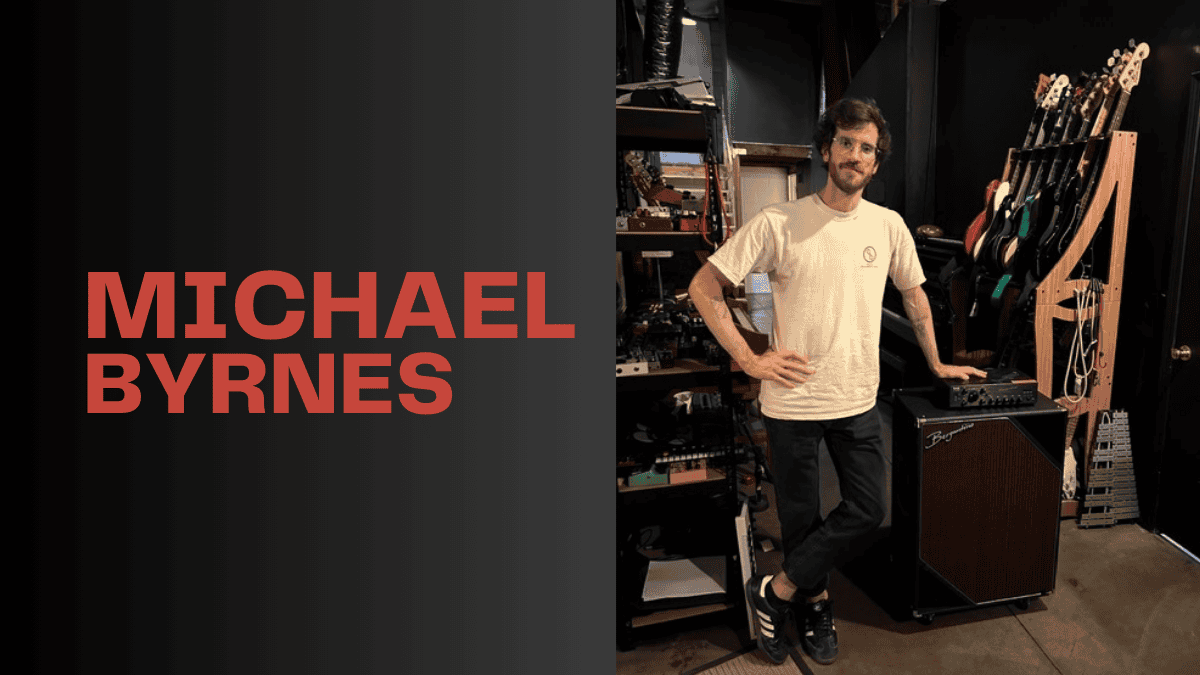
Interview and photo courtesy of Holly Bergantino of Bergantino Audio Systems
With an expansive live show and touring, Mt. Joy bassist Michael Byrnes shares his experiences with the joyful, high-energy band!
Michael Byrnes has kept quite a busy touring schedule for the past few years with his band, Mt. Joy. With a philosophy of trial and error, he’s developed quite the routines for touring, learning musical instruments, and finding the right sound. While on the road, we were fortunate to have him share his thoughts on his music, history, and path as a musician/composer.
Let’s start from the very beginning, like all good stories. What first drew
you to music as well as the bass?
My parents required my sister and I to play an instrument. I started on piano and really didn’t like it so when I wanted to quit my parents made me switch to another instrument and I chose drums. Then as I got older and started forming bands there were never any bass players. When I turned 17 I bought a bass and started getting lessons. I think with drums I loved music and I loved the idea of playing music but when I started playing bass I really got lost in it. I was completely hooked.
Can you tell us where you learned about music, singing, and composing?
A bit from teachers and school but honestly I learned the most from just going out and trying it. I still feel like most of the time I don’t know what I am doing but I do know that if I try things I will learn.
What other instruments do you play?
A bit of drums but that’s it. For composing I play a lot of things but I fake it till I make and what I can’t fake I will ask a friend!
I know you are also a composer for film and video. Can you share more
about this with us?
Pretty new to it at the moment. It is weirdly similar to the role of a bass player in the band. You are using music to emphasize and lift up the storyline. Which I feel I do with the bass in a band setting. Kind of putting my efforts into lifting the song and the other musicians on it.
Everybody loves talking about gear. How do you achieve your “fat” sound?
I just tinker till it’s fat lol. Right now solid-state amps have been helping me get there a little quicker than tube amps. That’s why I have been using the Bergantino Forté HP2 – Otherwise I have to say the cliche because it is true…. It’s in the hands.
Describe your playing style(s), tone, strengths and/or areas that you’d like
to explore on the bass.
I like to think of myself as a pretty catchy bass player. I need to ask my bandmates to confirm! But I think when improvising and writing bass parts I always am trying to sneak little earworms into the music. I want to explore 5-string more!
Who are your influences?
I can’t not mention James Jamerson. Where would any of us be if it wasn’t for him? A lesser-known bassist who had a huge effect on me is Ben Kenney. He is the second bassist in the band Incubus and his playing on the Crow Left the Murder album completely opened me up to the type of bass playing I aspire towards. When I first started playing I was really just listening to a lot of virtuosic bassists. I was loving that but I couldn’t see myself realistically playing like that. It wasn’t from a place of self-doubt I just deep down knew that wasn’t me. Ben has no problem shredding but I was struck by how much he would influence the song through smaller movements and reharmonizing underneath the band. His playing isn’t really in your face but from within the music, he could move mountains. That’s how I want to play.
What was the first bass you had? Do you still have it?
A MIM Fender Jazz and I do still have it. It’s in my studio as we speak. I rarely use it these days but I would never get rid of it.
(Every bass player’s favorite part of an interview and a read!) Tell us about
your favorite bass or basses. 🙂
I guess I would need to say that MIM Jazz bass even though I don’t play it much. I feel connected to that one. Otherwise, I have been playing lots of great amazing basses through the years. I have a Serek that I always have with me on the road (shout out Jake). Also have a 70’s Mustang that 8 times out of 10 times is what I use on recordings. Otherwise, I am always switching it up. I find that after a while the road I just cycle basses in and out. Even if I cycle out a P bass for another P bass.
What led you to Bergantino Audio Systems?
My friend and former roommate Edison is a monster bassist and he would gig with a cab of yours all the time years ago. Then when I was shopping for a solid state amp the Bergantino Forté HP2 kept popping up. Then I saw Justin Meldal Johnsen using it on tour with St. Vincent and I thought alright I’ll give it a try!
Can you share a little bit with us about your experience with the Bergantino
forte HP amplifier? I know you had this out on tour in 2023 and I am pretty
certain the forte HP has been to more countries than I have.
It has been great! I had been touring with a 70’s SVT which was great but from room to room, it was a little inconsistent. I really was picky with the type of power that we had on stage. After a while, I thought maybe it is time to just retire this to the studio. So I got that Forte because I had heard that it isn’t too far of a leap from a tube amp tone-wise. Plus I knew our crew would be much happier loading a small solid state amp over against the 60 lbs of SVT. It has sounded great and has really remained pretty much the same from night to night. Sometimes I catch myself hitting the bright switch depending on the room and occasionally I will use the drive on it.
You have recently added the new Berg NXT410-C speaker cabinet to your
arsenal. Thoughts so far?
It has sounded great in the studio. I haven’t gotten a chance to take it on the road with us but I am excited to put it through the paces!
You have been touring like a madman all over the world for the past few
years. Any touring advice for other musicians/bass players? And can I go to Dublin, Ireland with you all??
Exercise! That’s probably the number one thing I can say. Exercise is what keeps me sane on the road and helps me regulate the ups and downs of it. Please come to Dublin! I can put you on the guest list!
It’s a cool story on how the Mt. Joy band has grown so quickly! Tell us
more about Mt. Joy, how it started, where the name comes from, who the
members are and a little bit about this great group?
Our singer and guitarist knew each other in high school and have made music together off and on since. Once they both found themselves living in LA they decided to record a couple songs and put out a Craigslist ad looking for a bassist. At the time I had just moved to LA and was looking for anyone to play with. We linked up and we recorded what would become the first Mt. Joy songs in my house with my friend Caleb producing. Caleb has since produced our third album and is working on our fourth with us now. Once those songs came out we needed to form a full band to be able to do live shows. I knew our drummer from gigging around LA and a mutual friend of all of us recommended Jackie. From then on we’ve been on the road and in the studio. Even through Covid.
Describe the music style of Mt. Joy for me.
Folk Rock with Jam influences
What are your favorite songs to perform?
Always changing but right now it is ‘Let Loose’
What else do you love to do besides bass?
Exercise!
I always throw in a question about food. What is your favorite food?
I love a good chocolate croissant.
Follow Michael Byrnes:
Instagram: @mikeyblaster
Follow Mt. Joy Band:
Instagram: https://www.instagram.com/mtjoyband
Facebook: https://www.facebook.com/mtjoyband
Bass Videos
Artist Update With Mark Egan, Cross Currents
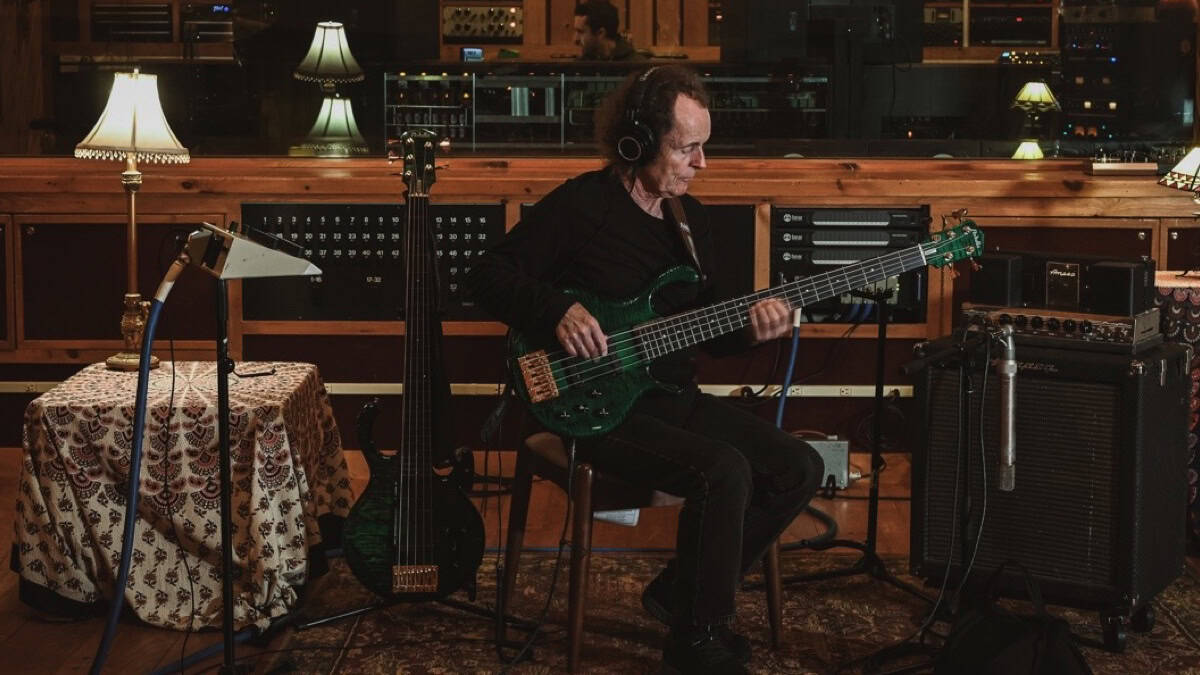
I am sure many of you are very familiar with Mark Egan as we have been following him and his music for many years now. The last time we chatted was in 2020.
Mark teamed up with drummer Shawn Pelton and guitarist Shane Theriot to produce a new album, “Cross Currents” released on March 8th, 2024. I have been listening to this album in its entirety and it is simply superb (See my review).
Now, I am excited to hear about this project from Mark himself and share this conversation with our bass community in Bass Musician Magazine.
Photo courtesy of Mark Egan
Visit Online:
markegan.com
markegan.bandcamp.com
Apple Music
Amazon Music
Bass Videos
Interview With By the Thousands Bassist Adam Sullivan
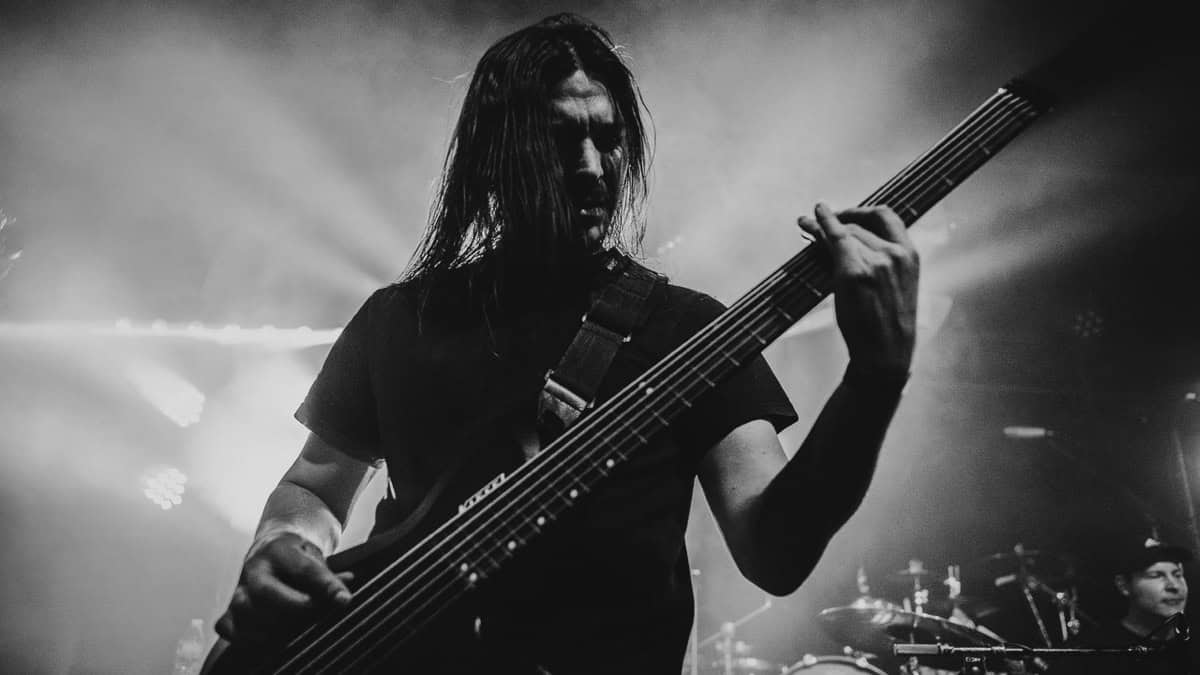
Bassist Adam Sullivan…
Hailing from Minnesota since 2012, By the Thousands has produced some serious Technical Metal/Deathcore music. Following their recent EP “The Decent”s release, I have the great opportunity to chat with bassist Adam Sullivan.
Join me as we hear about Adam’s musical Journey, his Influences, how he gets his sound, and the band’s plans for the future
Photo, Laura Baker
Featured Videos:
Follow On Social
IG &FB @bythethousands
YTB @BytheThousands











